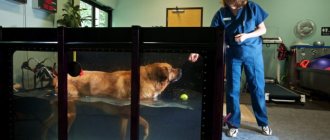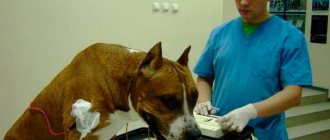Why does pulmonary edema appear in a dog?
Edema is the accumulation of fluid in the airways, air sacs (alveoli), or lung tissue.
He can be:
- cardiogenic;
- caused by pathologies outside the heart.
Circulatory disorders, infections, and an allergic reaction of the body lead to swelling. Head trauma and high blood pressure can also cause the disease. All pulmonary edema in dogs manifests itself in the same way. But they are divided into cardiogenic and non-cardiogenic due to the difference in treatment methods.
Did you know? The dog inhales air through the nostrils and exhales through slits located on the sides of the nose. Therefore, she does not lose her “smell settings” when looking for an object.
Cardiogenic
Cardiogenic pulmonary edema is associated with slowed blood flow and stagnation of fluid in the capillaries (congestive heart failure).
Causes include the following pathologies and dietary habits:
- high sodium diet;
- cardiomyopathy;
- mitral valve regeneration;
- dysfunction of the heart valve or aorta;
- pulmonary artery blockage;
- hypertension;
- Congenital heart defect;
- cardiosclerosis;
- heart failure.
After operation
The disease can develop as a reaction to general anesthesia during surgery. Most often this happens against the background of existing chronic diseases of a cardiogenic and non-cardiogenic nature. Therefore, before surgery, it is necessary to conduct a complete examination of the dog.
Other reasons
The list of non-cardiogenic causes is much wider.
Here are some of them:
- electrical injury;
- head injury;
- cancer;
- inhalation of large amounts of smoke;
- pneumonia;
- toxins, including snake venom;
- sepsis;
- airway obstruction;
- suffocation;
- laryngeal paralysis;
- severe stress;
- allergy;
- acute respiratory distress syndrome;
- heatstroke;
- kidney disease;
- pancreatitis;
- leptospirosis;
- anemia.
Important! To help your dog recover from illness, introduce lean meats into your diet: chicken, lamb, turkey and fish.
Symptoms of fluid in the lungs of a dog
When a dog is swollen, it has trouble breathing.
Among the symptoms:
- rapid breathing;
- presence of shortness of breath;
- mouth breathing;
- dry cough;
- noticeable abdominal breathing;
- bluish mucous membranes of the mouth;
- Possible bloody foam from the nose.
The dog stands or sits, but does not lie down. When listening, crackling noises are heard in the lungs. You can quickly help your pet with an oxygen supplement. This will provide some relief, but to treat the swelling you will need to get full treatment from a veterinarian.
How is the diagnosis carried out?
Obtaining a medical history and physical examination are the first steps in diagnosing pulmonary edema.
Vet:
- listen to the dog’s chest with a stethoscope to determine how the lungs “sound” when inhaling and exhaling;
- Checks the heart for murmurs between beats or changes in rhythm and heart rate.
Did you know? The most popular breeds in the world are Labradors, German Shepherds, and Golden Retrievers. Moreover, Labradors have held the palm for 24 years in a row.
Many veterinarians take a chest x-ray to confirm the diagnosis. After this, you may be advised to conduct additional examination to identify the nature of the fluid and possible causes of swelling. Based on the results of this, a course of treatment will be prescribed.
It can be:
- Ultrasound of the heart;
- analysis of gas composition and blood clotting;
- pleural puncture.
Treatment with drugs
Treatment of pulmonary edema in dogs consists of the following steps:
- stabilization of condition;
- treatment of edema;
- eliminating the underlying disease.
Oxygen therapy (oxygen therapy) may be required for stabilization. And since edema often becomes the cause for the development of pneumonia, antibiotics must be prescribed along with other methods of treatment.
To treat edema, medications are prescribed that will help organize the outflow of excess fluid - a dropper. In a diluted state, the liquid comes out faster. They are placed intravenously and since it is difficult to do this at home, the pet will need to be hospitalized. Periodically, the doctor may take repeated x-rays of the lungs to monitor how well the fluid is draining.
The difference between cardiogenic and non-cardiogenic edema is that in the first type, the swelling is relieved with diuretics. In the second case, they do not matter, since the lung tissues swell due to other diseases. For example, pancreatitis, sepsis, leptospirosis, etc.
Important! If your pet is discharged with a diuretic prescribed
-
Monitor for signs of dehydration or electrolyte imbalance.
Their symptoms are
lethargy, depression, gastrointestinal disturbances or seizures.
In this case, you need to stop giving the diuretic and call your veterinarian. Progress of treatment of cardiogenic edema:
- Treatment will begin with oxygen therapy and some rest. To do this, use a mask that is connected to an oxygen cylinder or a special oxygen chamber.
- Diuretics will be prescribed Furosemide or Lasix. In some cases, stronger drugs are prescribed, for example, Spironolactone, Hydrochlorothiazide (diuretics) or a vasodilator - a vasodilator.
- Further medications to support the heart and a low-sodium diet are prescribed.
Preventive measures
The dog needs complete and good care. If she moves a lot and leads an active lifestyle, then she also needs rest. In addition, she needs to be given the opportunity to privacy.
We recommend reading: How to Treat Flatulence and Diarrhea in a Kitten
Particular attention should be paid to dogs predisposed to heart disease. Such owners should always have the necessary medications in their first aid kit to support cardiac activity. Dog owners must be proficient in CPR.
It is equally important to establish a proper balanced diet. The health and activity of your four-legged pet depends on this.
The animal must be periodically shown to a veterinarian for a preventive examination. This is a guarantee of early diagnosis of dangerous pet diseases.
The lungs are the most important respiratory organ, both in humans and in dogs, and are paired. In turn, they consist of alveoli. The main purpose of the lungs is gas exchange, that is, the intake of oxygen and the removal of carbon dioxide into the external environment. In order for this process to occur correctly, each alveolus is surrounded by a tiny network of capillaries. Finally, they communicate with the system of veins and arteries.
Care during recovery from pulmonary edema
The recovery period is faster in young dogs and worse in older ones. It is important to always follow your veterinarian's instructions and not stop treatment yourself.
To help you recover, follow these simple recommendations:
- In the first days after discharge, the dog should rest more. It is recommended to limit your mobility for a week.
- Keep your pet on a leash when outdoors. Avoid long walks and active games. Avoid jumping.
- If your pet has a poor appetite, feed him freshly prepared food. It contains protein and carbohydrates in a 1:1 ratio. This could be chicken and boiled rice (potatoes, pasta). It is important to use low fat meat.
- Provide soft and thicker bedding. This is because some dogs have trouble regulating their body temperature.
Important! The lethal dose for dogs is 4 mg of sodium per 1 kg of body weight. For reference: a teaspoon of salt weighs about 5 g.
For recovery, you will also need a diet low in sodium, i.e. table salt. Salt itself promotes the accumulation of fluid in the body. If we are talking about dry food, then it should contain less than 0.5% sodium. For those who must be strictly limited in this component, choose food with an indicator of less than 0.1%.
How to identify a dislocation and provide emergency assistance
Naturally, the first symptom indicating problems with the musculoskeletal system is lameness or unnatural posture. A dislocation of the front paw is accompanied by a tightening of the limb and a “slumping” gait. If a dog cannot get up after sleeping or whines when lying down, there may be several possible diagnoses - dislocation of the hind paw, joint pathologies (arthritis), weakness, muscle strain. The main sign of hip dislocation is that the paw is tucked in and “falls” inward; when injured, the dog also tucks the paw in, but keeps it in the correct axis.
So, what to do if your dog is injured and you suspect a dislocation:
- Do not panic - the injury is serious, painful, but not fatal.
- After providing first aid, be sure to take the dog to the clinic or call a veterinarian at home.
- Carefully examine the dog, make sure there are no tissue tears and the animal can move independently. If the hip joint is dislocated, do not let your pet walk! Calm and hold while lying on your side, the injured joint should be on top.
- Put a muzzle on your pet; even the most faithful and obedient dog can behave inappropriately when in severe pain.
- If necessary, the pet is carried on a mobile stretcher or a tightly stretched blanket.
- Do not try to reduce dislocations yourself! Closed injuries can be associated with internal bleeding and ligament ruptures.
- When fixing the joint with an elastic bandage, do not use a tight wrap. The elastic bandage tightens as you wear it. The ideal option is to apply a soft splint and fix the limb above and below the injured joint.
- Wrap the swollen joint in film and several layers of cloth, then apply ice - a basic measure that prevents bleeding and relieves pain.
- Monitor the temperature of the fixed limb; if the paw becomes colder, loosen the bandage.
- Do not demand an immediate answer from the veterinarian on how to treat your pet or a telephone consultation. Dislocation is confirmed by x-ray, with the exception of palpation in case of injury to the patella.
- If the dog whines or howls, it is necessary to give an anesthetic injection. In the absence of allergies and acute reactions, ketanol (ketanov), baralgin, or, in extreme cases, analgin, are suitable. If your dog has had acute reactions to medications and you don’t know what medications to give, use only veterinary medications, a universal pain reliever -.
- Inject 1/2 dose according to the dog's weight, the pet should feel pain, otherwise it will begin to lean on the limb, which will worsen the condition.
Forecast
Usually the prognosis for treatment is good if treatment is started quickly. Cardiogenic pulmonary edema in dogs takes a little longer to heal due to the pathologies associated with it. It can recur and this worsens the prognosis. Edema does not affect life expectancy. Additionally, this condition may develop gradually. But if it is not cured, then fluid stagnation leads to the development of pneumonia and the pet dies within a couple of months.
Swelling after injuries can be treated well and after recovery the animal will live as usual. As for the disease, which is based on cardiac problems, it can recur and also be accompanied by complications. How long the dog will live in this case depends on how successfully the cardiovascular system is treated.
Causes of the disease
There are enough factors that provoke the development of pneumothorax in dogs. Thus, in veterinary practice, a traumatic type of pneumothorax is distinguished and a spontaneous one.
The first type of pathology occurs in a dog against the background of mechanical damage. Traumatic pneumothorax is diagnosed in dogs when the dog falls from a height (even a small one), during strong impacts and collisions with a car. A dog of a decorative breed can get seriously injured if it unsuccessfully wriggles out of the owner’s hands and hits the floor.
If your small pet receives a minor injury, you should seek help from a veterinarian. The specialist will conduct an examination and prescribe appropriate treatment if necessary.
Wounds located in the sternum area can cause accumulation of gases or air in the pleural area. Various lacerations or bite wounds, as well as fractures of the rib structures (sometimes shots from dog hunters), lead to the fact that atmospheric pressure penetrates the pulmonary structures, provoking a change in pressure inside the sternum.
Blunt trauma to the sternum, resulting in rupture of bronchial structures, provokes the development of not only pneumothorax, but also hemothorax (a pathology characterized by the accumulation of blood around the pulmonary structures and causing compression).
The second type of pathology – spontaneous pneumothorax, is diagnosed in domestic dogs less often than traumatic one. The spontaneous type of pathological changes in the pleural cavity is no less dangerous to the life of a pet than traumatic one. The main factors in the development of this type of pathology are neoplasms and diseases of the pulmonary structures of infectious or non-infectious origin.










